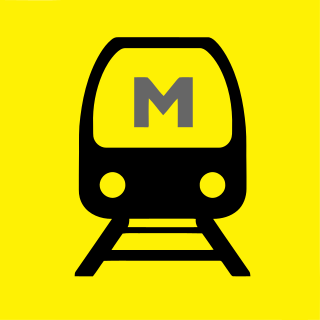
Rapid transit systems operate in six major South Korean cities, except for Ulsan and Sejong.
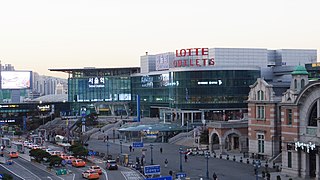
Seoul Station is a major railway station in Seoul, the capital of South Korea. The station is served by the Korail Intercity Lines and the commuter trains of the Seoul Metropolitan Subway.

Hyundai Rotem is a South Korean company that manufactures rolling stock, defense products and plant equipment. It is a part of the Hyundai Motor Group. Its name was changed from Rotem to Hyundai Rotem in December 2007 to reflect the parent company.

Seoul Subway Line 7 of the Seoul Metropolitan Subway was built from 1990 to 1996 and was completed on August 1, 2000 ; the western section between Sinpung and Onsu was put into service on February 29, 2000. This north-south line does not run through the city centre but links Gangnam directly to the northeastern districts of Seoul. In 2019, Line 7 had an annual ridership of 380 million or 1.04 million passengers per day. Although most trains run between Jangam and Seongnam, some trains short turn at Onsu station and some trains start at Dobongsan station.
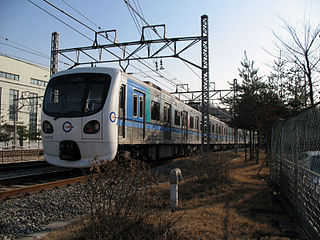
Incheon Subway Line 1 is a 29.4-kilometer (18.3 mi) north-south subway line, part of the Incheon Subway system. The line is also included as a part of the overall Seoul Metropolitan Subway network; Bupyeong Station has a free transfer with Seoul Subway Line 1, Gyeyang Station connects with the AREX Line which leads to Incheon International Airport and Seoul Station, Bupyeong-gu Office Station has a free transfer with Seoul Subway Line 7, and Woninjae Station has a free transfer with the Suin-Bundang Line.
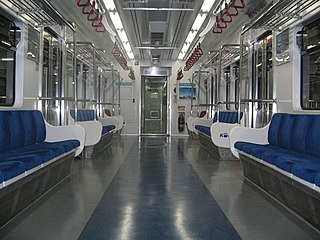
There are many types of trains in Seoul but they are generally similar to each other. All Seoul Metropolitan Subway rolling stock follow the Japanese-style commuter/subway train interior layout of all-longitudinal seating with luggage racks above seats. Typically, train cars have four pairs of doors on each side. In between the doors are rows of either cushioned or non-cushioned seats for 7 people, except for the outer ends of each wagon where there are smaller rows of seats for 3 people, marked for the use by the elderly, disabled passengers, and pregnant women.

Gimpo International Airport Station is a subway, railway and light rail station on Seoul Subway Line 5, Line 9, AREX, the Gimpo Goldline and the Seohae Line. True to its name, it serves the nearby Gimpo Airport, the hub of domestic flights in the Seoul metropolitan area as well as limited flights to/from China, Japan, and Taiwan. Upon its opening in 1996, it became the first railway station in the Korean Peninsula to directly serve an airport.

The Yeongjong Bridge(영종대교) is a self-anchored suspension double-deck road-rail bridge located in Incheon, South Korea, linking Yeongjong Island to the Korean mainland. The bridge is part of the Incheon International Airport Expressway and was completed in 2000.

AREX is a South Korean airport rail link and commuter rail line that links Incheon International Airport with Seoul Station via Gimpo International Airport. The section between the two airports opened on March 23, 2007, and line was extended to Seoul Station on December 29, 2010. Long-distance Korea Train Express high speed trains started to use the line from June 30, 2014, but discontinued service in March 2018 due to low ridership.

Hongik University Station is a station on Seoul Subway Line 2, AREX and the Gyeongui–Jungang Line. As its name indicates, it serves the nearby Hongik University. It was formerly known as Donggyo Station, after the neighborhood that it serves.

Gangseo District (Gangseo-gu) is one of the 25 wards (gu) of Seoul, South Korea. It is located on the south side of the Han River. Gimpo Airport is in Gonghang-dong, where many flights fly to cities like Busan, Jeju, and Gwangju.
Seoul, the capital and largest city in South Korea, accounts for only 0.6% of the country's total land area, yet it is home to around 19% of the population. The population density in Seoul demands a great deal of the city's transportation systems, which are regarded by many as among the best and most advanced in the world. Seoul is very well connected by its subway and bus systems, and the city is also very supportive of pedestrian foot travel. In 2006 it won the Sustainable Transport Award.
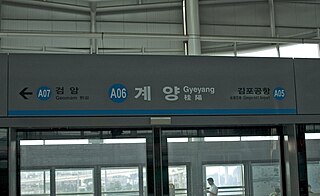
Gyeyang station is the northern terminus of Line 1 of the Incheon Subway. It is also a railway station on AREX, a railway linking Seoul Station and Incheon International Airport.
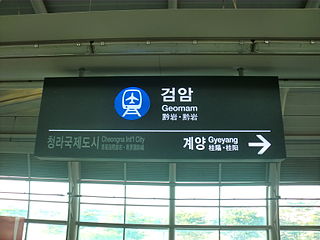
Geomam station is a railway station on AREX and Incheon Subway Line 2. Since June 2014, the KTX train operates from Incheon International Airport to Busan or Mokpo. It has stopped operating KTX since March 2018. In September 2018, Korail officially announced that they would stop operating KTX to Incheon International Airport due to lack of passenger use. This was the first KTX station after Incheon Airport. Before KTX started to run on AREX, all platforms were high-leveled with screen doors. The KTX started to run, they took away the platform screen doors only at the both end of the side horizontally and turned into low-leveled platform without screen doors.
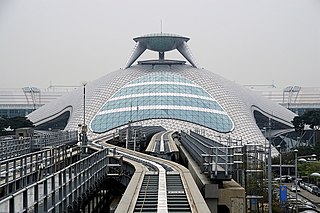
Incheon International Airport Terminal 1 Station is a railway station on AREX and the Incheon Airport Maglev. It is in Incheon International Airport's transport center near Terminal 1.
AREX is a South Korean railway line that links Seoul with Gimpo Airport and Incheon International Airport.

The UM12C is a type of diesel-electric locomotive manufactured by GE for Southeast Asian rail operators. It is currently in service with the State Railway of Thailand. It was also operated by the Manila Railroad Company and the Philippine National Railways from 1956 until 1999. While the units for both companies feature a shovelnose layout, the MRR locomotives were single-ended and had a cowl unit cab, the SRT locomotives are double-ended cab forward units.
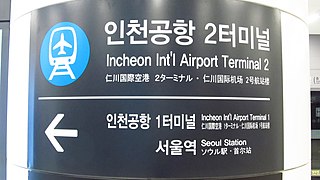
Incheon International Airport Terminal 2 station is a railway station on AREX.

The Taoyuan Metro 2000 series, also referred to as Express Trains, are the electric multiple unit train types that are used for the limited-stop Express services on the Taoyuan Airport MRT.





















